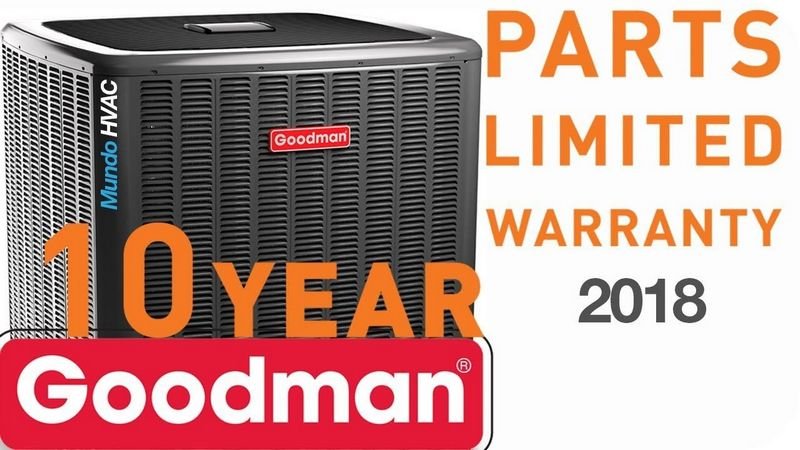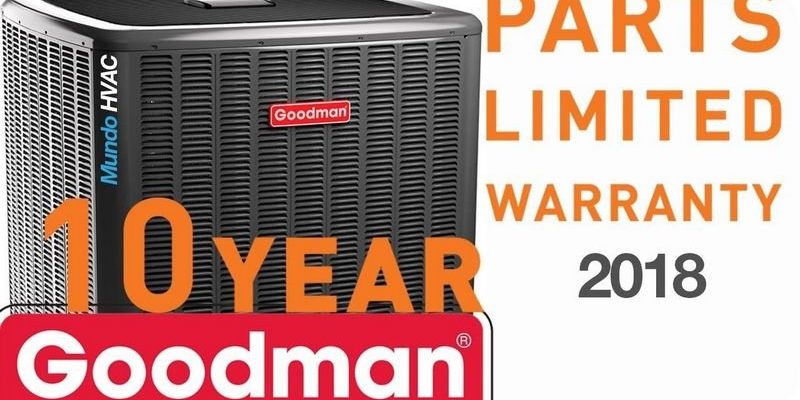
Think of a warranty as the seatbelt for your HVAC investment. You hope you’ll never need it, but when that first odd rattle or airflow hiccup pops up, you’ll want to know exactly how your Goodman warranty has your back. Let’s walk through what the standard Goodman HVAC system warranty actually covers, how long it lasts, and what you need to know to get the most out of it.
What Does Goodman’s Standard Warranty Actually Cover?
Here’s the thing: not all HVAC warranties are created equal, and Goodman’s approach is pretty straightforward, but there are some important details you’ll want to know. The Goodman standard warranty wraps around two main parts of your HVAC system: the parts themselves and, for some models, the compressor and heat exchanger.
Parts Warranty: Most new Goodman HVAC systems, whether you’re looking at an air conditioner, furnace, or heat pump, will come with a 10-year parts limited warranty. This means if a covered part fails because of a manufacturing defect, Goodman will send you a replacement part.
Compressor and Heat Exchanger: For central air units and heat pumps, there’s a separate limited lifetime warranty on the compressor or heat exchanger for certain higher-end models. For others, you’ll typically see a 10-year or 20-year period instead. The exact coverage hinges on the specific model—more on that in a bit.
But let me be clear: This warranty only covers parts—not labor. So, if you need a technician to install a new part, you’ll usually pay for their time. There are other details about what’s not covered (like damage from improper installation, lack of maintenance, or acts of nature), so always read those fine print sections. Honestly, it’s not thrilling reading, but it can save you headaches later.
How Long Is The Standard Goodman HVAC Warranty?
You might be wondering, “Is it really just ten years across the board?” It’s almost that simple, but not quite. The standard warranty for Goodman HVAC systems is 5 years for parts—unless you take an extra step. If you register your product with Goodman within 60 days of installation, that warranty bumps up to 10 years for parts on most models. It’s a classic “don’t forget to send in the paperwork” scenario.
Here’s a quick table to give you a feel for what you get:
| Coverage Type | Unregistered (Default) | Registered (Within 60 Days) |
| Parts Limited Warranty | 5 Years | 10 Years |
| Compressor or Heat Exchanger (Certain Models) | 10 Years / Lifetime (varies) | 10 Years / Lifetime (varies) |
Let me break it down: if you buy a Goodman HVAC and never register it, you’ll have five years of parts coverage. Register within 60 days, and you’re upgraded to ten years. For higher-end units, like the Goodman DSXC18 or GMVM97, you might even get lifetime coverage on the compressor or heat exchanger after registering.
Why Registration Matters (And How To Do It)
If you ignore all else, remember this: registering your Goodman HVAC is the key to unlocking the full warranty period. It’s a little like activating a new phone or syncing a universal remote—it takes a few minutes, but it means the difference between a basic and a deluxe safety net.
Registering is simple. You’ll need:
- The model and serial number
- Installation date
- Your installer’s information
- Your contact info
Go to the Goodman website and look for the “Product Registration” page. Enter the details, hit submit, and you’re good. If you’re tech-savvy, you’ll breeze through the process. If you’re less comfortable online, your HVAC pro can usually help sync things up for you.
Don’t wait too long. If you miss that 60-day window, you’re stuck with the default 5-year warranty. I’ve seen plenty of folks get stuck paying out of pocket for something that could’ve been covered—just because they forgot to send in their info.
Common Warranty Problems: What Isn’t Covered?
Let me explain: even with a strong warranty, there are a few pitfalls you’ll want to sidestep. Here’s what people often trip over:
- Labor isn’t included. That means Goodman supplies replacement parts, but you pay for the repair work. Some installers offer an add-on “labor warranty,” so ask up front!
- Lack of maintenance voids coverage. If you skip regular filter changes or annual tune-ups, you might have trouble with a claim. Keep records of your service visits—think of it as resetting the system for another year of trouble-free use.
- Improper installation cancels your warranty. Always use a licensed, trusted contractor. DIY installs usually lead to headaches down the road—and almost always void your warranty.
- External damage isn’t covered. Power surges, floods, or accidental damage aren’t on the warranty’s list. Consider a surge protector for extra peace of mind.
If you do need to make a claim, have your original paperwork and registration email handy, and try to troubleshoot the problem with your installer first. Sometimes the fix is as simple as a battery change in the thermostat remote, or a minor code reset on the control board.
Here’s a tip: “When in doubt, check your warranty registration and call your installer before you panic. A little patience can save a lot of stress.”
Comparing Goodman’s Warranty to Other Brands
Honestly, the HVAC world is crowded, and warranties are one way brands compete for your trust. Goodman’s standard warranty is pretty competitive, but how does it stack up?
Many big brands (like Trane, Carrier, Lennox) offer similar 10-year limited parts warranties if you register your system promptly. Some may add a labor allowance or cover more specific components for longer periods. Others restrict warranty terms for systems bought online or not installed by approved contractors.
What sets Goodman apart is its straightforward registration process and the lifetime compressor or heat exchanger coverage on certain models. If you’re weighing universal versus brand-specific parts, remember: a brand warranty, like Goodman’s, usually makes getting replacement parts and troubleshooting much smoother.
If you don’t have your original remote code, or you’re pairing a universal thermostat or controller with your Goodman system, always double-check what might void your warranty. Sticking to brand-approved accessories is usually the safest bet for keeping your full protection.
What To Do If You Need To Make a Warranty Claim
Let’s say your Goodman HVAC system starts making strange noises, or stops blowing cold air right in the middle of a summer heat wave. Don’t panic—here’s how the warranty claim process usually goes:
- Step 1: Contact your original installer or a licensed Goodman service provider. They’ll help diagnose the issue, reset or troubleshoot minor problems, and confirm if you have a warranty claim.
- Step 2: Gather your registration details, proof of purchase, and maintenance records. This step is a bit like finding the battery door on a remote—sometimes tricky, but necessary.
- Step 3: If the installer confirms a parts defect covered under warranty, they’ll order the replacement part from Goodman. You’re responsible for the labor cost.
- Step 4: Once the replacement arrives, your technician will install it, pair any necessary codes, and get your system synced and running again.
Remember, patience is key. Delays can happen, especially in busy seasons. Sometimes, even a seasoned pro can take a few tries to troubleshoot which part failed, just like figuring out which remote pairs with which device on a crowded coffee table.
Tips For Getting The Most From Your Goodman HVAC Warranty
Here’s what I’d tell a friend over a cup of coffee: the Goodman HVAC warranty is a solid deal—if you treat it right. A few small habits can make a huge difference.
- Register your unit as soon as possible. Don’t risk losing five years of extra coverage over a missed deadline.
- Schedule regular maintenance.
- Keep all paperwork in a safe place. That includes proof of purchase, warranty registration, and service records.
- Use authorized Goodman parts and accessories if you ever need replacements. Using universal or off-brand parts can sometimes void your warranty, so it’s not worth the risk.
- Ask your installer about labor warranties if you want extra peace of mind.
Think of it the same way you’d treat a long-distance road trip: check your oil, keep your documents handy, and go with factory parts when something needs fixing.
In Closing: Is Goodman’s Warranty Worth It?
At the end of the day, the standard Goodman HVAC warranty offers solid protection—especially if you remember to register your unit. You get up to 10 years on parts, and on some models, a lifetime backup on the most critical components. That’s a long stretch of protection in the world of home heating and cooling.
If you’re the kind who likes to troubleshoot things yourself—resetting error codes, changing batteries, syncing remotes—the warranty means you’ve got help on standby if something goes beyond your DIY skills. If you’d rather call in a pro, it’s there for you too, even if you’ll cover the labor costs.
So, next time you hear your Goodman system quietly kicking on, take a second to appreciate your safety net. It’s not flashy, but in the world of HVAC, knowing how long your warranty lasts is one less thing to sweat about.
